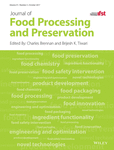The effects of different cooking methods on the formation of heterocyclic aromatic amines in turkey meat
Funding information: This research was supported by the Scientific and Technological Research Council of Turkey (TÜBİTAK) with Project No: 214O399
Abstract
The effects of different cooking methods (boiling, pan-frying without oil, deep-fat frying, hot plate, oven and microwave cooking) on formation of heterocyclic aromatic amines (HCAs) in turkey breast and leg meats were investigated. Effect of cutting meat on pH values of the samples was found to be significant (P < .01) and cooking methods showed significant effects (P < .01) on water contents of the samples. Following the cooking, a decrement and an increment in water contents and pH values of the samples were observed, respectively. Importantly, AαC and MeAαC were not presented in any of the samples cooked with different methods whereas IQx and MeIQx were detected in all samples. The total HCAs levels in breast and leg meat ranged between 2.90 and 52.34 ng/g, 2.38 and 21.35 ng/g, respectively. The highest total HCA contents in breast and leg meat were found to be in deep-fat fried samples followed by oven cooked samples.
Practical applications
Heterocyclic aromatic amines (HCAs) are mutagenic and/or carcinogenic compounds formed naturally during the cooking of protein rich foods such as beef, poultry, and fish. Due to the fact that the formation of HCAs is related to the cooking methods, the HCAs formation as affected by various cooking methods has to be investigated. To date, more than 30 reports on HCAs content in poultry such as chicken, turkey, duck and goose have been published. On the other hand, studies are limited in the literature on turkey meat. The present study was therefore undertaken in an attempt to investigate the effects of different cooking methods (boiling, pan-frying without oil, deep-fat frying, hot plate, oven and microwave cooking) on the formation of HCAs in turkey breast and leg meats.




